Canada is a country in North America. Its ten provinces and three territories extend from the Atlantic to the Pacific and northward into the Arctic Ocean, covering 9.98 million square kilometers, making it the world’s second-largest country by total area. Its southern and western border with the United States, stretching 8,891 kilometers, is the world’s longest bi-national land border. Canada’s capital is Ottawa, and its three largest metropolitan areas are Toronto, Montreal, and Vancouver.
Canada is a parliamentary democracy and a constitutional monarchy in the Westminster tradition. The country’s head of government is the prime minister—who holds office by virtue of their ability to command the confidence of the elected House of Commons—and is appointed by the governor general, representing the monarch, who serves as head of state. The country is a Commonwealth realm and is officially bilingual at the federal level. It ranks among the highest in international measurements of government transparency, civil liberties, quality of life, economic freedom, and education. It is one of the world’s most ethnically diverse and multicultural nations, the product of large-scale immigration from many other countries. Canada’s long and complex relationship with the United States has had a significant impact on its economy and culture.
A highly developed country, Canada has the 26th highest nominal per-capita income globally and the sixteenth-highest ranking in the Human Development Index. Its advanced economy is the ninth-largest in the world, relying chiefly upon its abundant natural resources and well-developed international trade networks. Canada is part of several major international and intergovernmental institutions or groupings including the United Nations, NATO, the G7, the Group of Ten, the G20, the Organization for Economic Co-operation and Development (OECD), the World Trade Organization (WTO), the Commonwealth of Nations, the Arctic Council, the Organization international de la Francophone, the Asia-Pacific Economic Cooperation forum, and the Organization of American States.
By total area (including its waters), Canada is the second-largest country in the world, after Russia. The physical geography of Canada is widely varied. Boreal forests prevail throughout the country, ice is prominent in northern Arctic regions and through the Rocky Mountains, and the relatively flat Canadian Prairies in the southwest facilitate productive agriculture.
Canada has over 2,000,000 lakes—563 of which are greater than 100 km2, containing much of the world’s fresh water.
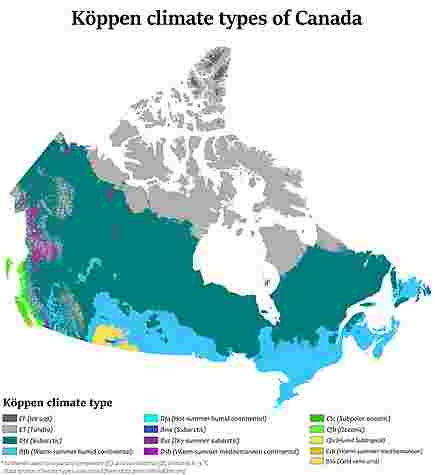
Average winter and summer high temperatures across Canada vary from region to region. Winters can be harsh in many parts of the country, particularly in the interior and Prairie provinces, which experience a continental climate, where daily average temperatures are near −15 °C (5 °F), but can drop below −40 °C (−40 °F) with severe wind chills. Coastal British Columbia has a temperate climate, with a mild and rainy winter. On the east and west coasts, average high temperatures are generally in the low 20s °C (70s °F), while between the coasts, the average summer high temperature ranges from 25 to 30 °C (77 to 86 °F), with temperatures in some interior locations occasionally exceeding 40 °C (104 °F)
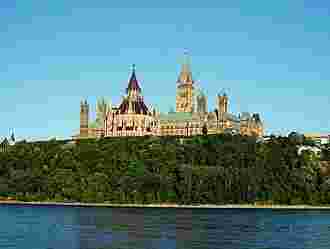
Photo: Parliament Hill, home of the federal government in Canada’s capital city, Ottawa
Canada is described as a “full democracy”, with a tradition of liberalism and an egalitarian, moderate political ideology. An emphasis on social justice has been a distinguishing element of Canada’s political culture. Peace, order, and good government, alongside an implied bill of rights are founding principles of the Canadian government.
At the federal level, Canada has been dominated by two relatively centrist parties, the Centre-left leaning Liberal Party of Canada and the Centre-right leaning Conservative Party of Canada. Five parties had representatives elected to the Parliament in the 2021 election—the Liberal Party, who currently form a minority government; the Conservative Party, who are the Official Opposition; the New Democratic Party; the Bloc Québécois; and the Green Party of Canada
Canada has a parliamentary system within the context of a constitutional monarchy—the monarchy of Canada being the foundation of the executive, legislative, and judicial branches. The reigning monarch is Queen Elizabeth II, who is also monarch of 14 other Commonwealth countries and each of Canada’s 10 provinces. While the monarchy is the source of authority in Canada, in practice its position is mainly symbolic. The use of the executive powers is directed by the Cabinet, a committee of ministers of the Crown responsible to the elected House of Commons and chosen and headed by the prime minister.

Photo: The Toronto financial district
Canada is the world’s tenth-largest economy as of 2018, with a nominal GDP of approximately US$1.73 trillion. It is one of the least corrupt countries in the world, and is one of the world’s top ten trading nations, with a highly globalized economy.
Since the early 20th century, the growth of Canada’s manufacturing, mining, and service sectors has transformed the nation from a largely rural economy to an urbanized, industrial one. Like many other developed countries, the Canadian economy is dominated by the service industry, which employs about three-quarters of the country’s workforce. However, Canada is unusual among developed countries in the importance of its primary sector, in which the forestry and petroleum industries are two of the most prominent components.
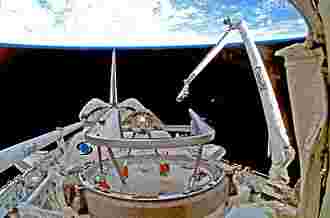
Photo: The Canadarm robotic manipulator in action on Space Shuttle Discovery
Canada was ranked fourth worldwide for scientific research quality in a major 2012 survey of international scientists. Canada has one of the highest levels of Internet access in the world, with over 33 million users, equivalent to around 94 percent of its total 2014 population. Canada was ranked 17th in the Global Innovation Index in 2019 and 2020. The Canadian Space Agency operates a highly active space program, conducting deep-space, planetary, and aviation research, and developing rockets and satellites. Canada was the third country to design and construct a satellite after the Soviet Union and the United States.
Canada has one of the highest per-capita immigration rates in the world, driven mainly by economic policy and also family reunification. The Canadian public, as well as the major political parties, support the current level of immigration. In 2019, a total of 341,180 immigrants were admitted to Canada, mainly from Asia. India, Philippines and China are the top three countries of origin for immigrants moving to Canada. New immigrants settle mostly in major urban areas in the country, such as Toronto, Montreal and Vancouver. Canada also accepts large numbers of refugees, accounting for over 10 percent of annual global refugee resettlements, it resettled more than 28,000 in 2018. Canada’s population density, at 3.7 inhabitants per square kilometer , is among the lowest in the world. About four-fifths of the population lives within 150 kilometers of the border with the contiguous United States. The most densely populated part of the country, accounting for nearly 50 percent, is the Quebec City–Windsor Corridor in Southern Quebec and Southern Ontario along the Great Lakes and the Saint Lawrence River. An additional 30 percent live along the British Columbia Lower Mainland and the Calgary–Edmonton Corridor in Alberta.
Healthcare in Canada is delivered through the provincial and territorial systems of publicly funded health care, informally called Medicare. Universal access to publicly funded health services “is often considered by Canadians as a fundamental value that ensures national health care insurance for everyone wherever they live in the country. However, 30 percent of Canadians’ healthcare is paid for through the private sector. This mostly goes towards services not covered or partially covered by Medicare, such as prescription drugs, dentistry and optometry. Approximately 65 to 75 percent of Canadians have some form of supplementary health insurance related to the aforementioned reasons; many receive it through their employers or utilizes secondary social service programs related to extended coverage for families receiving social assistance or vulnerable demographics, such as seniors, minors, and those with disabilities.

Photo: Aerial view of UBC (the Vancouver Campus)
Education in Canada is for the most part provided publicly, funded and overseen by federal, provincial, and local governments. Education is within provincial jurisdiction and the curriculum is overseen by the province. Education in Canada is generally divided into primary education, followed by secondary education and post-secondary. Education in both English and French is available in most places across Canada. Canadian provinces and territories are responsible for education provision. Canada has a large number of Universities, almost all of which are publicly funded.
The largest university is the University of Toronto with over 85,000 students. Four universities are regularly ranked among the top 100 world-wide, namely University of Toronto, University of British Columbia, McGill University and McMaster University, with a total of 18 universities ranked in the top 500 worldwide. Canada is one of the most educated countries in the world; the country ranks first worldwide in the number of adults having tertiary education, with over 56 percent of Canadian adults having attained at least an undergraduate college or university degree. The mandatory education age ranges between 5–7 to 16–18 years and contributing to an adult literacy rate of 99 percent.
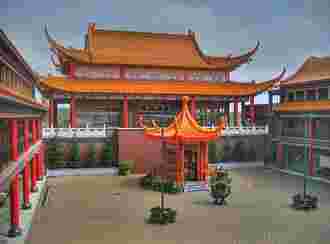
Photo: Ling Yen Mountain Temple in Richmond, British Columbia
Canada is religiously diverse, encompassing a wide range of beliefs and customs. Canada has no official church, and the government is officially committed to religious pluralism. Freedom of religion in Canada is a constitutionally protected right, allowing individuals to assemble and worship without limitation or interference. The practice of religion is now generally considered a private matter throughout society and the state.
A multitude of languages are used by Canadians, with English and French (the official languages) being the mother tongues of approximately 56 percent and 21 percent of Canadians, respectively. English and French have equal status in federal courts, Parliament, and in all federal institutions. Citizens have the right, where there is sufficient demand, to receive federal government services in either English or French and official-language minorities are guaranteed their own schools in all provinces and territories. The 1977 Charter of the French Language established French as the official language of Quebec. Although more than 85 percent of French-speaking Canadians live in Quebec, there are substantial Francophone populations in New Brunswick, Alberta, and Manitoba; Ontario has the largest French-speaking population outside Quebec. New Brunswick, the only officially bilingual province, has a French-speaking Acadian minority constituting 33 percent of the population.
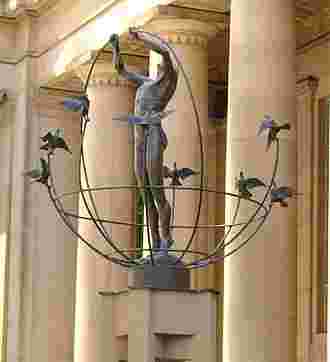
Photo: Monument to Multiculturalism
Canada’s culture draws influences from its broad range of constituent nationalities, and policies that promote a “just society” are constitutionally protected. Canada has placed emphasis on equality and inclusiveness for all its people. Multiculturalism is often cited as one of Canada’s significant accomplishments, and a key distinguishing element of Canadian identity. In Quebec, cultural identity is strong, and there is a French Canadian culture that is distinct from English Canadian culture. However, as a whole, Canada is, in theory, a cultural mosaic—a collection of regional ethnic subcultures.
Canada’s approach to governance emphasizing multiculturalism, which is based on selective immigration, social integration, and suppression of far-right politics, has wide public support. Government policies such as publicly funded health care, higher taxation to redistribute wealth, the outlawing of capital punishment, strong efforts to eliminate poverty, strict gun control—alongside legislation with a social liberal attitude toward women’s rights (like pregnancy termination), LGBTQ rights, are indicators of Canada’s political and cultural values.

Photo: Maple leaf
Canada’s national symbols are influenced by natural, historical, and Indigenous sources. The use of the maple leaf as a Canadian symbol dates to the early 18th century. The maple leaf is depicted on Canada’s current and previous flags, and on the Arms of Canada.The Arms of Canada are closely modelled after the royal coat of arms of the United Kingdom with French and distinctive Canadian elements replacing or added to those derived from the British version. Other prominent symbols include the national motto “A Mari Usque Ad Mare” (“From Sea to Sea”), the sports of ice hockey and lacrosse, the beaver, Canada goose, common loon, Canadian horse, the Royal Canadian Mounted Police, the Canadian Rockies, and more recently the totem pole and Inuksuk. Material items such as Canadian beer, maple syrup, tuques, canoes, Nanaimo bars, butter tarts and the Quebec dish of poutine are defined as uniquely Canadian. Canadian coins feature many of these symbols: the loon on the $1 coin, the Arms of Canada on the 50¢ piece, the beaver on the nickel. The penny, removed from circulation in 2013, featured the maple leaf. The Queen’s image appears on $20 bank notes, and on the obverse of all current Canadian coins.
Canada has developed a vast music infrastructure, that includes church halls, chamber halls, conservatories, academies, performing arts centers, record companies, radio stations and television music video channels. The Canadian music industry is the sixth-largest in the world, producing internationally renowned composers, musicians and ensembles.

Photo: Canada’s ice hockey
Canada’s official national sports are ice hockey and lacrosse. Golf, Soccer, Baseball, Tennis, Skiing, badminton, volleyball, cycling, swimming, bowling, rugby union, canoeing, equestrian, squash, and the study of martial arts are widely enjoyed at the youth and amateur levels. Great achievements in Canadian sports are recognized by Canada’s Sports Hall of Fame, while the Lou Marsh Trophy is awarded annually to Canada’s top athlete by a panel of journalists. There are numerous other Sports Halls of Fame in Canada.
Canada shares several major professional sports leagues with the United States. Canadian teams in these leagues include seven franchises in the National Hockey League, as well as three Major League Soccer teams and one team in each of Major League Baseball and the National Basketball Association. Other popular professional sports in Canada include Canadian football, which is played in the Canadian Football League, National Lacrosse League lacrosse, and curling.
Canada has 10 Provinces and 3 Territories. Click on each province to read more.
Canadian culture includes cultures from around the world. Canada is known as one of the world’s great multicultural societies and is proud of this.
Canada welcomes people from all over the world. Canada values the tolerance of different cultures. Canadian National Human Rights Act prohibits discrimination based on race, gender, disability and sexual orientation. Each province and territory of Canada has its own human rights code.
Canadians have a strong sense of justice. This means that Canada cares about people’s rights in the workplace, the judiciary, democracy and their homes. Women’s rights are equally important.
Commitment to equality has made Canada a destination for international students and immigrants. Canada is currently ranked as the best country in the world in terms of quality of life.
Every year on the first day of July, Canadians around the world celebrate their national day. This day was named National Day of Canada because of the founding of the Constitution of Canada on July 1, 1867. On this day, the three existing colonies united to form the country of Canada. It was originally named United Kingdom Day under British rule, but in 1982, after Canada’s independence from the United Kingdom and the constitutional name was changed to national law. Canada, this day was renamed Canada National Day.
Sources of some Photos and Content of this page: Wikipedia, vcn.bc.ca, caribbean days.ca, dailyhive.com, mtl.org, Vancouver Sun
It is your duty in life to save your dream
AMEDEO MODIGLIANI